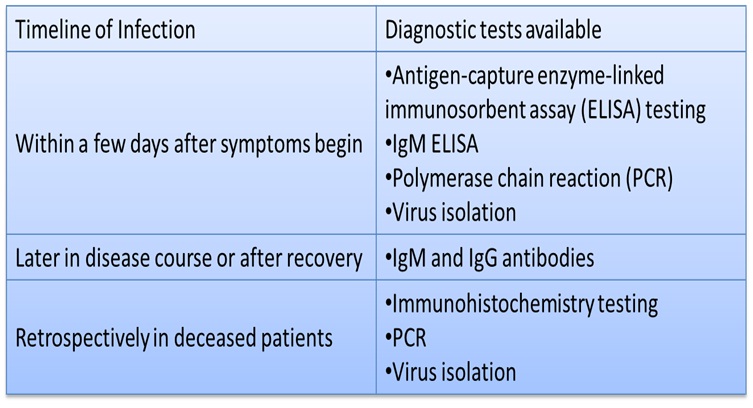





Published on Feb 13, 2025
The Ebola virus is a lipid enveloped virus in the family Filoviridae. Members of this family also include Marburg, Lassa, and other viruses that cause hemorrhagic fever, a group of illnesses that damage the vascular system and in severe cases, lead to bleeding under the skin, in internal organs or from body orifices (e.g. mouth, eyes and ears)1. Infection with the Ebola virus is now referred to as: Ebola virus disease (EVD)2. There is a diagnostic test to determine if the patient has EVD. There is no current FDA approved effective medication or treatment for those who become infected with Ebola other than supportive hydration, electrolyte balancing and oxygen. The death rate of those infected is between 50-90%. There is no vaccine or preventative treatment.

• Initial symptoms are nonspecific - may include fever, chills, myalgias, and malaise.
• Patients can progress to develop gastrointestinal symptoms:– severe watery diarrhea, nausea, vomiting, abdominal pain
– chest pain, shortness of breath, headache or confusion, conjunctival injection, hiccups, seizures, and cerebral edema
• Bleeding not universally present but can manifest later as petechiae, ecchymosis/ bruising, or oozing. Frank hemorrhage less common.
• Some develop diffuse erythematous maculopapular rash that can desquamate
• Diagnosing Ebola can be difficult at first since early symptoms, such as fever, are nonspecific to Ebola infection.
• However, if a person has the early symptoms and has had contact with Ebola they should be isolated and public health professionals notified.
• Samples from the patient can then be collected and tested to confirm infection.

• There are no approved treatments available for EVD.
• Clinical management focus - supportive care of complications:
– Hypovolemia, electrolyte abnormalities, hematologic abnormalities, refractory shock, hypoxia, hemorrhage, septic shock, multi-organ failure, and DIC.
• Recommended care includes:
– volume repletion
– maintenance of blood pressure (with vasopressors if needed)
– maintenance of oxygenation
– pain control
– nutritional support
– treating secondary bacterial infections and pre-existing comorbidities
• Among patients from West Africa, large volumes of intravenous fluids have often been required to correct dehydration due to diarrhea and vomiting.
• Several investigational therapeutics for Ebola virus disease are in development. There are no approved vaccines available for EVD. Several investigational Ebola vaccines are in development, and Phase I trials are underway for some vaccine candidates.
Person-to-person transmission occurs by very close personal contact with an infected individual or with their body fluids during the late stages of infection or after their death3,4. During the care of an infected individual, spread of the virus can occur through contact with infected body fluids on the patient, on their clothes or bedding, on surfaces such as bedrails, side tables, the floor, or on reused unsterilized syringes, needles, thermometers or other virus-contaminated medical equipment. Humans may also be infected by handling sick or dead non-human primates and are also at risk when handling the bodies of deceased humans in preparation for funerals5,6.
Virus containing body fluids from individuals infected with the Ebola virus:
• Blood
• Breast milk
• Organs and tissues
• Saliva
• Semen
• Stool
• Sweat
• Urine
• Vaginal secretions
• Vomit
• Amniotic fluid (possibly)
Note:Ebola virus has been isolated from semen 61 days after the initial symptoms of infection appear. Transmission through semen has occurred 7 weeks after clinical recovery
Incubation period: It requires 2 to 21 days (more often 4-9 days) before symptoms of infection occur. The infected individual is not contagious until symptoms appear. Hemorrhage begins to present 4-5 days after general symptom onset
Survival outside the body: The virus can survive and remain infective in liquid or dried material at room temperature for a number of days10 or at 39°F (4°C) for several days, and is indefinitely stable at -70°C. Infectivity can be preserved by lyophilization (freeze-drying)
August 26, 1976 in Yambuku, a town in the north of Zaïre.
A 44-year-old school teacher returned from a small hike. His went to the doctor and because of his high fever they gave him a quinine shot which is good against malaria.
A week later, he had uncontrolled vomiting, bloody diarrhea, trouble breathing and then bleeding from his nose, mouth, and anus.
He died ~14 days after the onset of symptoms.
He started an epidemic that killed 280 of the 313 infectedpersons (88%).
-- It struck two countries within that year
--a. Sudan – in a town called N’zara
b. Zaire, now known as the Democratic Republic of Congo
-- In these two instances the mortality rate was between 50 –90%
-- Following those epidemics, Ebola hit Africa in many other instances the worst yet being in the year 2000 when it struck Uganda infecting more than 400 people
• Biology textbook, NCERT
• www.wikipedia.com
• www.google/images.com
• www.NHLBI (National Heart, Lung, and Blood Institute).com